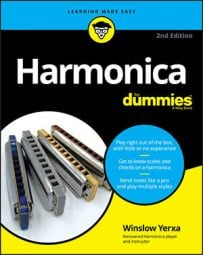When you arrange a tune on the harmonica, you work out the details of how you’ll present the tune to an audience to make it interesting and create the effect you want. Even a solo harmonica tune can benefit from arranging. The following points are all important elements to consider when you arrange a tune:
Picking a tempo: Should the tune be played fast or slow? Find the tempo, or speed, that sounds best with the tune. But do make sure it’s a tempo that’s within your ability to play.
Choosing a key: Choose a key that everyone is comfortable playing in. If someone will be singing the song, make sure that the key doesn’t make the melody too high or low for the singer. The singer may already know what key works for him or her, or you may have to try the song in a few different keys to be sure.
Beginning the tune: When deciding how to begin a tune, you have to ask yourself whether you want to launch right into the melody or play an introduction first. An introduction may consist of the last phrase of the tune and a little pause or it may involve playing rhythm without any melody and creating a mood or even suspense until you start the melody.
Ending the tune: You have to end somehow. Simply stopping on the last note may or may not work. Listen to other arrangements in the same style as your tune. Are there standard ending phrases that musicians tack on or do they use big, banging, crashing blowouts? Focus on endings when you listen to music and you’ll start to get some ideas.
Repeating the tune: When planning an arrangement, ask yourself how many times you want to play through the tune. You should play it enough times that it starts to become familiar to listeners (at least twice) but not so many times that you or they get tired of it (even the most gorgeous tune may get a little stale after seven or eight repetitions).
Changing to a different key: Changing key during a tune can add excitement, and if you can handle the change on one harmonica, this can be a fun challenge. Similarly, if you switch harmonicas in the middle of a tune without stopping, you can impress the audience.
Playing in contrasting ranges: Switching to the high or low register of the harmonica for part of the tune can create interesting contrasts.
Contrasting solo melody with accompanied melody: If you’re playing with accompaniment, try switching to unaccompanied melody. In fact, with some tunes, the entire performance may be most effective as solo melody. You can start with just melody and then add accompaniment. You can also drop out the accompaniment and then bring it back in later.
Passing the lead to another instrument for a change: If you’re playing with other musicians, you may want to freshen things up by bringing another instrument — or a singing voice — to the forefront.
Working out these details can help make a tune fun to play and fun to hear. If you’re onstage in front of an audience, a good arrangement can make the difference between just reciting the tune and performing it.

